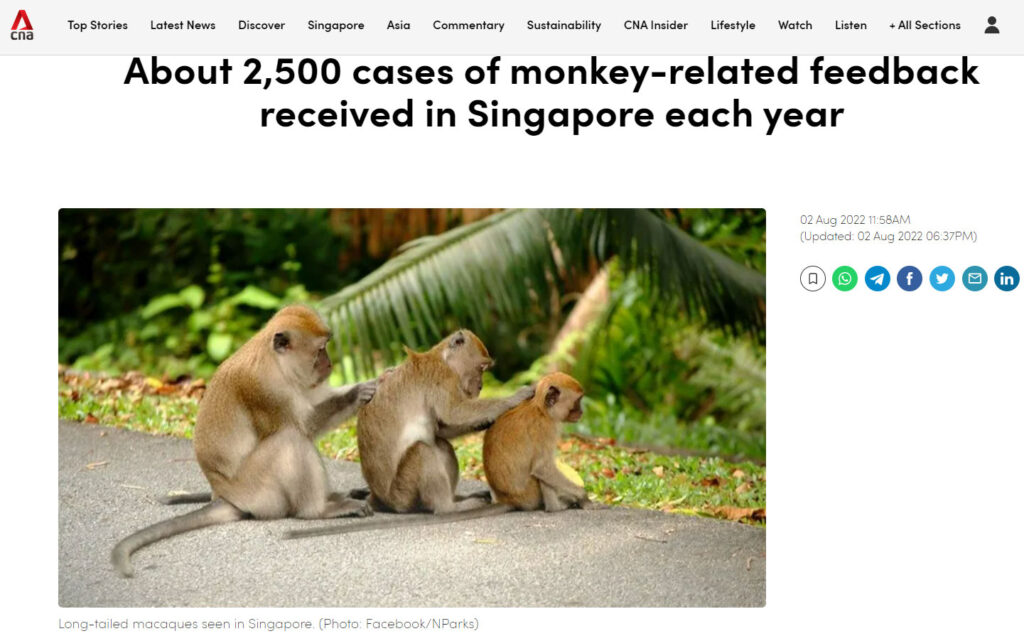Relating to the Natural World
Published
November 2, 2022
By
Xiaoyun Neo

Wild animals in Singapore are not unfrequently regarded as an inconvenience or terror, stirring feelings of disgust, anxiety and terror in public and private spaces — occasionally even causing physical harm to beloved community animals or pets.
Isolated clashes of the wild and the urban are sensationalised and dramatised. Mass media and its personalised negative recounts of animals in Singapore could entrench public attitudes toward these creatures as needing to be controlled, contained and even expelled from the urban landscape. In contrast, other possible attitudes and perceptions of animals are almost entirely absent.
With humans and animals living in close proximity in Singapore, how can we reframe wildlife encounters and experiences, while maintaining public safety and reducing human-wildlife conflicts?
Thankfully, we live in a storied society. This article is a taster of some traditions, beliefs and practices involving wild animals in Singapore’s environmental history, through which we can learn about alternative ways that the people of Singapore had related to nonhuman animals and the natural world. I posit that there are deep connections between humans and animals that are commonly overlooked in Singapore.

An Indian snake charmer. (National Museum of Singapore, National Heritage Board)
Revisiting the Cultural Roots of Snake Charming
To the curious onlooker, the snake charmer is an enigmatic character hynoptising and coaxing their snakes to sway to the music he plays on his flute. The cultural resonance of charming the snake is rooted in Hindu myths that venerate it. Snakes have long been popular subjects of Hindu art, in the motif of Naga, a semi-divine race of half-human, half serpent beings that reside in the netherworld. Hindu Gods are pictured to be under the protection of the cobra. Snake charming itself is thus considered part of traditional Indian folk art. Attempts to hurt or kill snakes are sacrilegious.
Though often considered venomous, dangerous and otherwise unwelcome creatures in the urban landscape, snake charmers build up a bond and mutual trust with the snake via repeated gentle stroking. With the right techniques, the snake charmer could take between two weeks and six months to domesticate the snake. Even as the practice has become controversial today, we can nevertheless recognise the tradition of snake-charming and its cultural resonance as reflective of an association of the aesthetic, religious and even spiritual values with the animal.

(Pixabay)
Botanical and Ecological Advances with Macaques
The leading tropical botanist and ecologist E. J. H. Corner is perhaps known today for protecting the Botanic Gardens and Raffles Museum from looters during the Japanese Occupation of Singapore. What is lesser known is that Corner cared for macaques that in turn pioneered canopy ecology with him in 1937. Corner trained five Southern pig-tailed macaques to pick seeds, fruit, ferns and leaves from treetops as high as 50 metres. He named his favourite macaque Merah, and hoped that the macaques could pursue “their natural lives among the wild trees” while his task as a botanist was “to make use of this untrammeled enthusiasm.”
Enthusiastic and essential they were, for Merah himself brought over 300 unique plant specimens to Corner in just two years. This innovation of training and bonding with macaques to advance and assist scientific botany reflects the value of the macaque’s qualities to humans in ecologist science. In Corner’s own words:

(Photo by Neo Xiaoyun)
Healing Earth and Curing Humans with Sea Cucumbers
The Orang Laut, a significant community in the Kingdom of Johor throughout the 17th and 18th centuries, traded successfully in valuable sea products, such as tripang (sea cucumber). As a culture, they too valued the sea cucumber, believing it helpful towards healing any internal inflammations. As Firdaus Sani of oranglaut.sg shares, “if let’s say someone has just given birth, we would use the sea cucumbers as a way to cure internal bleeding.” Supported by their fishing expertise and knowledge of the waterways of the region, harvesting sea cucumbers was easy.
These unassuming animals dwell on the sandy, mucky bottoms of the sea. As they filter-feed for algae, plankton, waste particles and aquatic invertebrates in the water — and poop afterward — they assist with the dispersion of nutrients in the marine ecosystem, enriching the sediment that seagrasses grow on. The sea cucumbers’ expulsion of calcium carbonate also provides key ingredients for coral formation and for combating ocean acidification.
In recent years, the health benefit effects of sea cucumbers have been validated through scientific research. This presents a real opportunity for ethical, small-scale, sustainable sea cucumber fisheries, reflecting the continued relevance of indigenous beliefs of health, recuperation and recovery conferred by sea cucumbers.

(Photo by Dennis Nathaniel Chan, The Untamed Paths)
Coveting the Javan Mynas of Java
Often deemed pests, most Singaporeans would be surprised that the Javan myna — a non-native species — entered our ports as part of the pet trade. Approximately 100 years ago, the island’s bustling market places also sold live animals including Javan mynas. Introduced in 1924, the myna was valued for its looks, call and vivacious personality. Even with almost 100,000 of them in Singapore, the bird’s population is in decline in its native range of Java, where it relies on lowland forests that are being rapidly converted into plantation agriculture. Like a few other species (Racket-tailed Drongos and Long-tailed Parakeets), relying and living on the taller trees in Singapore has meant that deforestation has little impact on them so long as taller trees remained distributed around, in parks and park connectors, and along roadsides.
As veteran ecologist Sir David Attenborough puts it, “people must feel that the natural world is important and valuable and beautiful and wonderful and an amazement and pleasure.” Or in a local Malay peribahasa, Tak kenal maka tak cinta — literally, one cannot love what one does not know. We would be better able to develop empathy towards animals in Singapore, and give them some moral and ethical consideration for conservation when we are able to acknowledge their aliveness and the ways in which we, as a society, have been connected with and dependent on them for centuries, if not millennia.
Going forwards, I suggest being careful and conscious about the dramatisation of mass media that can stir discomfort and anxiety towards wildlife. If we can instead learn stories about the practices and traditions by which there has been healthy coexistence and the mutual sharing of space, it opens up new perspectives to rethink our coexistence with the nonhuman world and animals that live around us.
Sources
- Barnard, Timothy. 2019. “Imperial Creatures: Humans and Other Animals in Colonial Singapore”. NUS Press.



